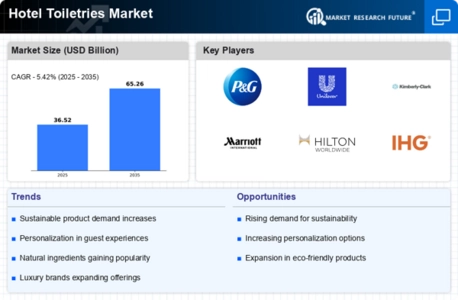Regulatory Compliance
Regulatory compliance is a critical driver in the Hotel Toiletries Market, as hotels must adhere to various health and safety standards. Governments worldwide are implementing stricter regulations regarding the ingredients used in personal care products, which directly affects the toiletries offered by hotels. Compliance with these regulations is essential to avoid penalties and maintain a positive reputation. Data shows that hotels that proactively address regulatory requirements can enhance their operational efficiency and reduce liability risks. As regulations continue to evolve, hotels must remain vigilant in their product offerings, ensuring that their toiletries meet the necessary standards while also appealing to consumer preferences.
Health and Wellness Trends
Health and wellness trends are significantly impacting the Hotel Toiletries Market. As consumers become more health-conscious, hotels are responding by offering toiletries that promote well-being, such as natural and organic products free from harmful chemicals. This shift aligns with the growing awareness of personal health and the desire for holistic experiences during travel. Recent studies indicate that hotels featuring wellness-oriented toiletries can attract a demographic that prioritizes health, potentially increasing occupancy rates. By incorporating wellness-focused products, hotels not only enhance the guest experience but also position themselves as leaders in a market that increasingly values health and sustainability.
Sustainability Initiatives
The Hotel Toiletries Market is increasingly influenced by sustainability initiatives. Hotels are adopting eco-friendly practices, which include the use of biodegradable packaging and organic ingredients in toiletries. This shift is driven by consumer demand for environmentally responsible products. According to recent data, approximately 70 percent of travelers express a preference for hotels that prioritize sustainability. As a result, many hotel chains are reformulating their toiletries to align with these values, thereby enhancing their brand image and attracting eco-conscious guests. The emphasis on sustainability not only addresses environmental concerns but also positions hotels favorably in a competitive market, potentially leading to increased customer loyalty and repeat business.
Technological Advancements
Technological advancements are reshaping the Hotel Toiletries Market, as hotels leverage innovative solutions to enhance guest experiences. The integration of smart technology in toiletries, such as dispensers that monitor usage and refill automatically, is gaining traction. This not only reduces waste but also streamlines operations for hotel staff. Furthermore, data suggests that hotels implementing such technologies can reduce their toiletry costs by approximately 20 percent. The adoption of technology in the toiletries sector reflects a broader trend towards efficiency and sustainability, appealing to modern travelers who value convenience and eco-friendliness. As technology continues to evolve, its impact on the toiletries market is likely to expand.
Customization and Personalization
Customization and personalization are emerging as pivotal trends within the Hotel Toiletries Market. Guests increasingly seek tailored experiences, prompting hotels to offer personalized toiletries that cater to individual preferences. This trend is reflected in the growing demand for bespoke amenities, such as custom-scented shampoos and conditioners. Data indicates that hotels providing personalized toiletries can enhance guest satisfaction by up to 30 percent. By investing in customization, hotels can differentiate themselves in a saturated market, thereby fostering a unique identity. This approach not only elevates the guest experience but also encourages positive reviews and recommendations, which are crucial for attracting new clientele.



.webp)
.webp)
.webp)
.webp)
.webp)
.webp)








Leave a Comment